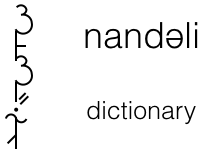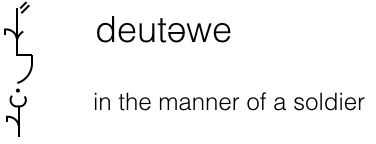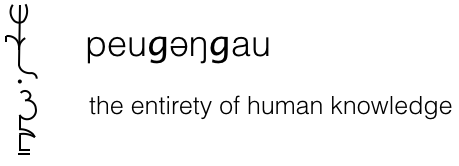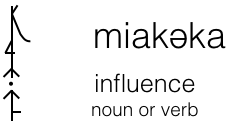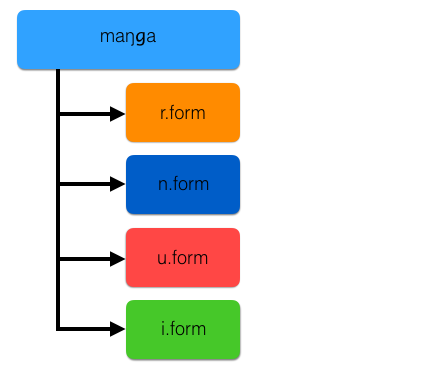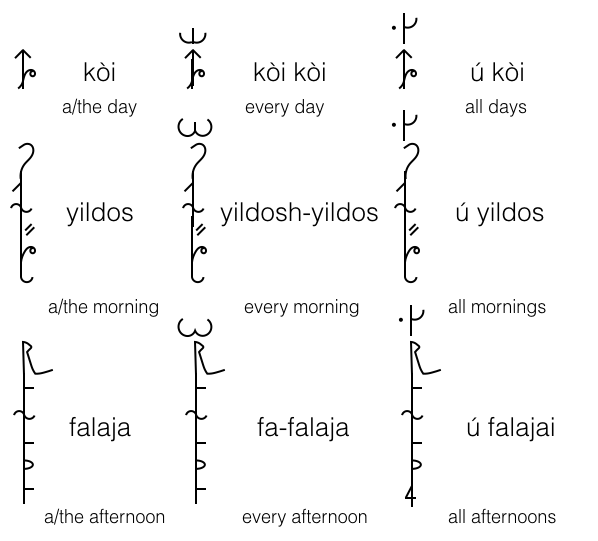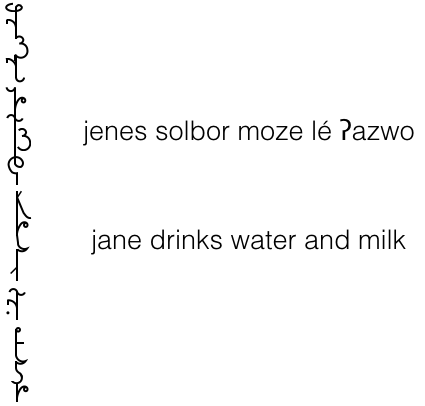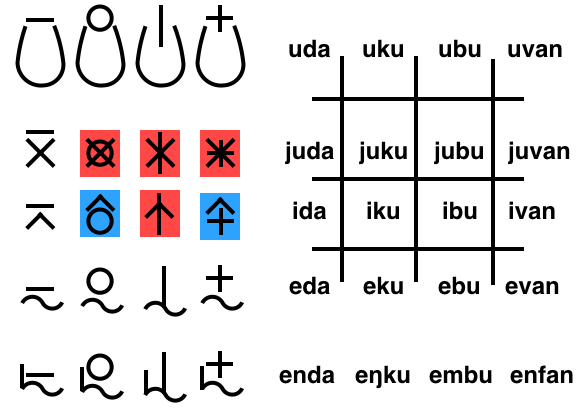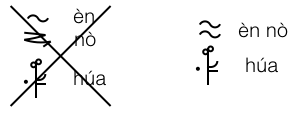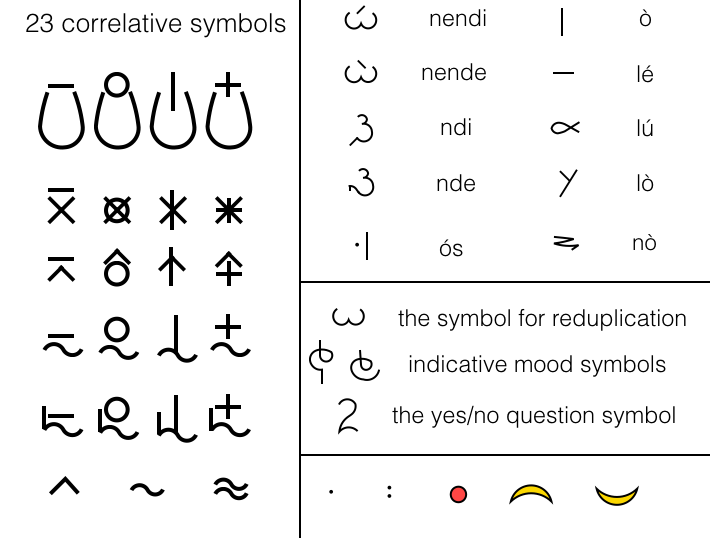Béu : Chapter 5 : Questions: Difference between revisions
| Line 1,131: | Line 1,131: | ||
.. | .. | ||
== | == ... Summary of non-alphabet non-numerical symbols == | ||
.. | .. | ||
[[Image: | [[Image:TW_593.png]] | ||
.. | .. | ||
Revision as of 19:54, 4 August 2016
..... Combining clauses
..
... With respect to time
..
huʒia = to smoke
koʔua = to cough
solbe = to drink
caume = medicine
..
... XXX
..
Grammar provides ways to make the stream of words coming out a speaker's mouth nice and smooth ... no lumpy bits. Well the smoothness comes from the rules (you can think of the rules as traffic rules, and affixes and particles as the traffic signs), and getting rid of the lumps entails dropping the elements that are already known, that are already accessible in the mind of the hearer. This section is about getting rid of these elements : both arguments and person-tense markers.
..
Now we have already come across the particle lé which links nouns together. béu doesn't use the same particle for linking clauses together though. It uses the particle è. English allows the dropping of an S or A argument in a sentence when this argument has already been established as the topic. béu is exactly the same : it allows the dropping of an S or A argument. However when you have a clause with the S argument dropped, this clause is not introduced by è, it is introduced by the particle sé. For example ...
A) bawa turi = The men came
B) bawas bwuri gala = The men saw some women
C) bawa turi sé bwuri gala = The men came and saw some women.
D) bawas bwuri gala è turi = The men saw some women and then came.
You can see that C) flows a lot better than A) juxtaposed with B). And D) flows a lot better than B) juxtaposed with A).
This seems a good place to list all the particles that can join clauses.
sé/è : these have nothing to say about the relative timing of clause A (before the particle) and clause B (after the particle).
sé dù/è dù : these mean that action B follows on immediately from action A.
sé kyude/è kyude : these mean that action B follows action A but not necessarily immediate. Sometimes sé è are dropped.
kyugo : this means that action A and B happen at the same time. Usually we have different actors in the two clauses, but not always.
Another particle used for combining clauses is tè. This is exactly equivalent to the English "but". tè is occasionally also used before nouns. However before nouns it is more usual to use ???
There are also some phrases with more "sound.weight" that have the exact same meaning as tè.
..
..... The three types of Verb
..
Some concepts are naturally intransitive. Like "to shave". Well at least in béu it is very unusual to shave another.
Some concepts are naturally transitive. Like "to hit". It is worth remarking on when somebody hits themselves.
And there are also some concepts that appear in both manifestations. For example ... "turn", "spread", "rise/raise"
These three types of concept are represented in beu by three different types of verb.
V1) té = to come ... this is a intransitive verb
(Always accompanied by a naked noun)
V2) timpa = to hit ... this is a transitive verb
(Always accompanied by an s-marked noun and a* naked noun)
*Although sometimes the naked noun can be dropped for lack of interest. For example ...
jenes solbori = Jane drank (something)
V3) kwèu = to turn
Now this sometimes behaves like V1 and sometimes like V2.
..
.. V1 Derivations
..
There are 5 deriuvation processes shown below ...
First from doika => doikaya This involves infixing ay before the final vowel.
Secondly from doika => doikana and doikaya => doikayana.
This involves deleting the final vowel and adding ana.
Thirdly from doika => doikala and doikaya => doikayala.
This involves deleting the second part of the final vowel if it is a diphthong, and then adding la.
Fourthly from doikaya => doikaiwai.
This involves deleting the final vowel and y and adding iwai.
Fifthly from doikaya => doikaiwau.
This involves deleting the final vowel and y and adding iwau.
..
| doikaiwai | doikaiwau | |||
| "that which has been made to walk" (A/N) | "that which must be made to walk" (A/N) | |||
| doikayana | <============ | doikaya | ============> | doikayala |
| "the one that makes walk" (N) | "to make to walk" (V1) | "causing to walk" (A) | ||
| ^ | ||||
| | | ||||
| | | ||||
| doikana | <============ | doika | ============> | doikala |
| "walker" (N) | "to walk" (V2) | "walking" (A) |
Note that we have 8 word forms in total.
..
.. V2 Derivations
..
There are 5 deriuvation processes shown below ...
First from kludau => kludawau This involves infixing aw before the final vowel.
Secondly from kludau => kludana and kludawau => kludawana.
This involves deleting the final vowel and adding ana.
Thirdly from kludau => kludala and kludawau => kludawala.
This involves deleting the second part of the final vowel if it is a diphthong, and then adding la.
Fourthly from kludau => kludwai.
This involves deleting the final vowel and adding wai.
Fifthly from kludau => kludwau.
This involves deleting the final vowel and adding wau.
..
| kludawana | <============ | kludawau | ============> | kludawala |
| "computer memory" (N) | "to be written" (V2) | "being written" (A) | ||
| ^ | ||||
| | | ||||
| | | ||||
| kludana | <============ | kludau | ============> | kludala |
| "writer" (N) | "to write" (V1) | "writing" (A) | ||
| kludwai | kludwau | |||
| "written" (A/N) | "which must be written" (A/N) |
..
kludwai is the passive past participle, and kludwau is the passive future participle.
..
Note that we have 8 word forms in total.
..
.. V3 Derivations
..
| haikana | <============ | haika | ============> | haikala |
| "breaker" (N) | "to break" (V3a) | "breaking" (A) | ||
| haikwai | haikwau | |||
| "broken" (A/N) | "that which must be broken" (A/N) |
..
Note ... haikwai could very well have broken by itself. There is no connotation that an outside agent was responsible. The same with haikwau.
..
| heukana | <============ | heuka | ============> | heukala |
| "breaker" (N) | "to break" (V3b) | "breaking" (A) |
..
There are 4 derivational processes involved with V3a and 2 derivational processes involved with V3b. They have been already been explained in the sections on V1 and V2.
Note that we have 8 word forms in total.
kó = to see
kowa = to be seen
The subject of the active clause, can be included in the passive clause as an afterthought if required. hí is a normal noun meaning "source". However it also acts as a particle (prefix) which introduces the agent in a passive clause.
poʔau = to cook
..
When the final consonant is w y h or ʔ the passive is formed by suffixing -wa
In monosyllabic words, it is formed by suffixing -wa.
Note ... when wa is added to a word ending in au or eu, the final u is deleted.
Also note ... these operations can make consonant clusters which are not allowed in the base words. For example, in a root word -mpw- would not be allowed ( Chapter 1, Consonant clusters, Word medial)
..
... Valency ... 1 => 2
..
Now all verbs that can take an ergative argument can undergo the 2=>1 transformation.
There also exists in béu a 1=>2 transformation. However this transformation can only be applied to a handful of verbs. Namely ...
| ʔoime | to be happy, happyness | ʔoimora | he is happy | ʔoimye | to make happy | ʔoimyana | pleasant |
| heuno | to be sad/sadness | heunora | she's sad | heunyo | to make sad | heunyana | depressing |
| taudu | to be annoyed | taudora | he is annoyed | tauju | to annoy | taujana | annoying |
| swú | to be scared, fear | swora | she is afraid | swuya | to scare | swuyana | frightening, scary |
| canti | to be angry, anger | cantora | he is angry | canci | to make angry | cancana | really annoying |
| yodi | to be horny, lust | yodora | she is horny | yoji | to make horny | yojana | sexy, hot |
| gái | to ache, pain | gayora | he hurts | gaya | to hurt (something) | gayana | painful * |
| gwibe | to be ashamed/shame/shyness | gwibora | she is ashamed/shy | gwibye | to embarrass | gwibyana | embarrassing |
| doimoi | to be anxious, anxiety | doimora | he is anxious | doimyoi | to cause anxiety, to make anxious | doimyana | worrying |
| ʔica | to be jealous, jealousy | ʔicora | she is jealous | ʔicaya | to make jealous | ʔicayana | causing jealousy |
ʔoimor would mean "he is happy by nature". All the above words take this sense when the "a" of the present tense is dropped.
The above words are all about internal feelings.
The third column gives a transitive infinitive (derived from the column two entry by infixing a -y- before the final vowel).
The fourth column gives an adjective of the transitive verb (derived from column three entry by affixing a -ana ... the active participle).
When the final consonant is ʔ j c w or h the causative is formed by suffixing -ya.
Also when the verb is a monosyllable, the causative is formed by suffixing -ya.
Note ... when ya is added to a word ending in ai or oi, the final i is deleted.
Note ... when y is infixed behind t and d : ty => c and dy => j
..
Normally in béu, to make a nominally intransitive verb transitive, it doesn't need the infixing of -y. All it needs is the appearance of an ergative argument. For example ...
doika = to walk
doikor = he walk
ós doikor the pulp mill = he runs the pulp mill
doikyana = management ???
..
*You would describe a gallstone as gayana. However you would describe your leg as gaila (well provided you didn't have a chronic condition with your leg)
..
Concatenation of the valency changing derivations ... 1 => 2 => 1 and 2 => 1 => 2
..
| ʔoime | = to be happy | ʔoimye | = to make happy | ʔoimyewa | = "to be made to be happy" or, more simply "to be made happy |
..
| fàu | = to know | fa?? | = to tell | fa ?? | = |
..
| timpa | = to hit | timpawa | = to be hit | timpawaya | = to cause to be hit |
..
Semantically timpa is direct action (from agent to patient). Whereas timpawaya is indirect, possibly involving some third party between the agent and the patient and/or allowing some time to pass, between resolving on the action and the action being done unto the patient.
..
..... Word building
..
Many words in béu are constructed from amalgamating two basic words. The constructed word is non-basic semantically ... maybe one of the concepts needed for a particular field of study.
..
In béu when 2 nouns are come together the second noun qualifies the first. For example ...
toili nandau (literally "book" "word") ... the thing being talk about is "book" and "word" is an attribute of "book".
Now the person who first thought of the idea of compiling a list of words along with their meaning would have called this idea toili nandau.
However over the years as the concept toili nandau became more and more common, toili nandau would have morphed into nandəli.
Often when this process happens the resulting construction has a narrower meaning than the original two word phrase.
There are 4 steps in this word building process ...
1) Swap positions : toili nandau => nandau toili
2) Delete syllable : nandau toili => nandau li
3) Vowel becomes schwa : nandau li => nandə li
4) Merge the components : nandə li => nandəli
..
..
The above example is for 2 non-monosyllabic words. In the vast majority of constructed words the contributing words are polysyllables.
The process is slightly different when a contributing word is a monosyllabic. First we look at the case when the main word is a monosyllable ...
wé deuta (literally "manner soldier")
1) Swap positions : wé deuta => *deuta wé ........ there is no step 2
3) Vowel becomes schwa : *deuta wé => *deutɘ wé
4) Merge the components : *deutə wé => deutəwe
..
..
And the case when the attribute is a monosyllable ...
nandau sài (literally "word colour")
1) Swap positions : *sài nandau
2) Delete syllable : *sài dau .......................................... there is no step 3
4) Merge the components : *sài dau => saidau
..
..
And the case when the attribute ends in a consonant ...
megau peugan ... "body of knowledge" "society"
1) Swap positions : *peugan megau
2) Delete syllable : *peugan gau
3) Delete the coda and neutralize the vowel :*peugan gau => *peugə gau
4) Merge the components :*peugən gau => peugəŋgau
..
..
And the case when the main word has a double consonant before the end vowel ...
kanfai gozo ... merchant of fruit
1) Swap positions : *gozo kanfai
2) Delete syllable : *gozo fai ............................. Note kan is deletes, not just ka
3) Vowel before the final consonant becomes schwa :*gozo fai => *gozə fai
4) Merge the components :*gozə fai => gozəfai
..
..
And here are a few examples to demonstrate the semantic range that this technique can encompass ...
laŋku = shadow, reflection
miaka = echo, response, effect
Which produce miakəka meaning "subtle influence" or "to subtly influence"
..
..
sword.spear => weaponry ... shield.helmet => armour, protection ... knife.fork => cuttlery ... table.chair => furniture
There are no cases where both contributing words are monosyllables.
Note ...
1) the schwa is represented by a sturdy dot.
2) the consonant before the schwa takes its final form
3) the consonant after the schwa takes its medial form
When spelling words out, this dot is pronounced as jía ... meaning "link".
Notice that when you hear nandəli, deutəwe or peugəgau you know that they are a non-basic words (because of the schwa).
Also when you see nandəli or deutəwe, peugəgau written you know that they are non-basic words (because of the dot).
However when you come across hipe it is not immediately obvious that it's a non-basic word.
This method of word building is only used for nouns.
..
..... Bicycles, Insects and Spiders
..
wèu = vehicle, wagon
weuvia = a bicycle
weubia = a tricycle
Perhaps can be thought of derived from an expression something like "wagon two-wheels-having" or "wagon double-wheel-having" with a lot of erosion.
Notice that the "item" that is numbered (i.e. wheel) is completely dropped ... probably not something that would evolve naturally.
There are not many words in this category.
jodoʒia* = spider
jodolia = insect
jodogia = quadraped
jodovia = biped
nodebia = a three-way intersection ... usually referring to road intersections.
nodegia = a four-way intersection
nodedia = a five-way intersection
nodelia = a six-way intersection ... and you can continue up of course.
*jodo = animal ... from jode = to move
..
..... Ambitransitive verbs
..
In English there are some verbs that sometimes take one participant and sometimes involve two participants. For example "knit" or "turn". In English you know if the verb is appearing in its intransitive form if an extra argument turns up after the verb (that is ... an O argument has turned up) ... S and A appear the same in English.
Similarly in béu there are some verbs that sometimes take one participant and sometimes take two participants. For example mekeu "knit" or kwèu "turn". In béu you know if the verb is appearing in its intransitive form if an extra argument turns up with the ergative marker -s attached (that is ... an A argument has turned up) ... S and O appear the same in béu.
Note on nomenclature
Dixon calls "knit"/mekeu an ambitransitive verb of type S=A or an [S=A ambitransitive verb].
I call "knit"/mekeu an ambitransitibe verb of type "one unaffected argument" or an [unaffected ambitransitive verb].
For "knit" the preverb argument* is either S or A .... For mekeu the unaffected argument is either S or A.
Dixon calls "turn"/kwèu is an ambitransitive verb of the type S=O or an [S=O ambitransitive verb].
I call "turn"/kwèu an ambitransitibe verb of type "one affected argument" or an [affected ambitransitive verb].
For "turn" the affected argument is either S or O .... For kwèu the naked argument** (i.e. no -s) is either S or O.
*It is also the unaffected argument.
**It is also the affected argument.
..
..... Live verbs
helga = life, helgai = alive, helgais = finite verb, helkas = a clause ( helkas <= helgaiskas ), swevan = a sentence
Lets take the solbe to explain these different forms. solbe is a maŋga and it would be found in the dictionary ... and if it was an English/ béu dictionary ... the translation "to drink" would lie alongside it.
An example of one of its (many) r.forms is solbori = He/she/it drank ....... so the r.form corresponds to a verb in indicative mood.
An example of one of its (handful of) s.forms is gò solban = I wish I could drink ....... corresponds to a sort of subjunctive mood.
The u.form (only one u.form per word) is solbu = drink ! ....................... so the u.form corresponds to a verb in imperative mood.
The i.form (only one i.form per word) is solbi ... this is the fornm used in verb chains and will be explained later.
We will go into a lot more detail about all these forms in the next chapter.
..
..
..... More on definiteness
..
In the section on word order we said that when the person being spoken to can identify X as one particular X ... then X will come before the verb, where X is any of the A O or S arguments.
However ... the above leaves undefined, whether the person speaking can identify X. This can be made explicit in béu by adding either the particle é or the participle fawai. For example ...
doikora bàu = A man is walking .... unknown to the person being spoken to : known-ness to the person speaking is not defined.
doikora é bàu = Some man is walking .... unknown to the person being spoken to : unknown to the person speaking.
doikora bàu fawai = A man is walking .... unknown to the person being spoken to : known to the person speaking.
This distinction is also made in certain natural languages. For example with nouns in Samoan ...
o sa fafine = a woman
o le fafine = a woman ……. unknown to you but known to me
Or between these two indefinite pronouns in Latin ...
aliquis = somebody
quidam = somebody ……. unknown to you but known to me
[ Note ... the argument qualified by é or fawai invariably come after the verb. Also, while it is possible to imagine some scenario where an argument is known to the person being spoken to but unknown to the person speaking, in reality this very very rarely happens and I know of no natural language that makes this distinction. ]
..
One interesting point .....
Take the sentence ... "She wants to marry a Norwegian"
How do we show the definiteness of the Norwegian in relation to the subject. That is ... does she have a certain Norwegian in mind or does she want to marry any Norwegian.
In English ... when you hear this sentence ... you will nearly always know from the context, which of the two meanings is meant.
"any" or "that she knows" could be added to make the distinction explicit within the sentence itself.
..
... Totality ... collectively or individually
..
Sometimes we want to talk about all members of the category "noun" acting (or being acted upon) COLLECTIVELY.
For this we use the particle ú before the plural of the noun. For example ...
moltai = a/the doctor
moltai.a = doctors
ú moltai = all doctors
Note ... the same word, when appended to a noun, means "the whole" or "entire". For example ...
falaja ú = all morning
..
The opposite of the above, is when all members of the category "noun" is acting (or is being acted upon) INDIVIDUALLY.
By doubling the noun (or the first part of a noun) you give what can be called a distributive meaning.
Some examples ...
kòi = day
kòi kòi = every day
moltai = doctor
moltai moltai = each doctor
falaja = afternoon
fa falaja = every afternoon
Notice that for words over two syllables, only the first syllable is prefixed.
..
The "word-hood" of these duplications is murky. I am writing them here as two separate words ... i.e. fa falaja. But maybe fafalaja or fa-falaja would be more appropriate.
Single syllable words retain there tone when duplicated ... which indicates two separate words. However you also get phonological processes that are usually only word internal. That is to say, these structures show "sandhi".
For example ...
yildos yildos (every morning) would be pronounced / jildoʃ jildos /
bàu bàu (every man) could be pronounced / bàu vàu /
Anyway ... these constructions are never written out in full. Instead a special symbol is placed above the simple noun. This symbol can vary a bit, depending on the font being used : it can vary from a lower half circle bisected by a vertical stroke to a shape that looks a bit like the Arabic shaddah.
For example ...
It some contexts, semantically, it does not matter whether the individual or the collective form is used. When this is the case, the default choice is "individual" structure. ú tends to be used with tangible nouns more, it is hardly ever used with nouns denoting periods of time.
Note (as in English) the plural verb form is used for the collective structure, the singular verb form for the individual structure. For example ...
ú bàu súr = all men are
bàu bàu sór = every man is
TO THINK ABOUT ...
?à ?à bàu hù ?ís = any man that you want ( ?ís ... "you would want" ???? )
?ài ?ài bàu hù ?ís = any men that you want
?ài bàu = some men
..
..... lé .... lú .... lò
..
Earlier we have seen that when 2 nouns come together the second one qualifies the first.
However this is only true when the words have no pilana affixed to them. If you have two contiguous nouns suffixed by the same pilana then they are both considered to contribute equally to the sentence roll specified. For example ...
jonos jenes solbur moze = "John and Jane drink water"
In the absence of an affixed pilana, to show that two nouns contribute equally to a sentence (instead of the second one qualifying the first) the particle lé should be placed between them. For example ...
jenes solbori moʒi lé ʔazwo = "Jane drank water and milk"
jonos jenes bwuri hói sadu lé léu ʔusʔa = John and Jane saw two elephants and three giraffes.
[ Compare the above two examples to á jono jene solbori moze = Jane's John drank water ... i.e. The John that is in a relationship with Jane, drank water ]
This word is that is never written out in full but has its own symbol. See below ...
..
Note ... in the béu script, the "o" before "r" is always dropped. This is just a sort of short hand thing.
..
The following construction is also found.
lé moze lé ʔazwo = "both water and milk"
The above construction emphasizes the "linking" word lé
Another linking word is lú meaning "or".
jenes blor solbe moze lú ʔazwo = "Jane can drink water or milk"
The following construction is also found.
lú moze lú ʔazwo = "either water or milk"
The above construction emphasizes the "linking" word lú
There is another word that corresponds to the English "or". This is ʔala and it is a question word. For example ...
ʔís moze ʔala ʔazwo = "would you want water or milk"
And the answer expected of would be either "water" or "milk"
Say you were asking somebody if they were thirsty and you had only water or milk to give them. Then you would say ... ʔís moze lú ʔazwo ʔai@
The expected answer to the above question would be either "yes" or "no" (as is always the case when you have @ ( @ is pronouced a bit like ʔai but has contour tone instead of a normal high tone, it has a special symbol and I am using "@" to represent this symbol in my transliteration)).
Now if the question was "would you want water or milk, or both" you should say ...
ʔís mose ʔala ʔazwo ʔala leume
But sometimes (either because of the laziness of the speaker or because the likelyhood was not considered) ... ʔís moze ʔala ʔazwo ʔala leume comes out as ʔís moʒi ʔala ʔazwo.
So ʔís leume (I would like both) is an acceptable answer to the question ʔís moze ʔala ʔazwo
If the questioner would like to rule out the answer ʔís leume he would use the construction .
ʔís ʔala moze ʔala ʔazwo
So ʔala before the first item does exactly the same as lé or lú before the first item : it emphasizes the linking word.
..
... "no"
..
In béu, jù corresponds to "no".
"neither water nor milk" would be translated as jù moʒi jù ʔazwo
..
... lists
..
So far we have restricted ourselves to two items. We can summarize the system for two items as below ...
..
| lé | giving | 2 | items | |||||
| lú | giving | 1 | item | ..... | ʔala | asking for | 1 | item |
| jù | giving | 0 | items |
..
However we can join up more than two items. When more than two items are joined by the above 4 linking words, it is considered good style to have the linking word before the first item and the last item, before each item (except the first and the last) should be a slight pause (I call it a gap ... see "punctuation and page layout" earlier on this page).
For example ...
jenes bwori lé ifa sadu _ uba ʔusʔa _ ega moŋgo lé oda gaifai falaja dí = Jane saw two elephants, three giraffes, four gibbons and five flamengos this morning.
..
... other
..
lò = other
lòi = others
kyulo = again
welo = otherwise
..
..... Correlatives
..
..
| uda | everywhere | uku | always | ubu | everybody | uvan | everything |
| juda | nowhere | juku | never | jubu | nobody | juvan | nothing |
| ida | anywhere | iku | anytime | ibu | anybody | ivan | anything |
| eda | somewhere | eku | sometime | ebu | somebody | evan | something |
| enda | some places | eŋku | some times | embu | some people | enfan | somethings |
..
The above 20 correlatives all have a special symbols (ignore the blue and red squares). A further 3 of these special symbols are shown below ....
..
..
..
The short-hand forms (symbols) are always used.
The columns are related to the words ... dàn = place ... kyùs = time/occasion ... glabu = person ... fanyo = thing
ubu can mean "each person" and "all the people". If they act together uwe can be added. If they act individually bajawe' can be added.
..
... Summary of non-alphabet non-numerical symbols
..
..
.. Set Phrases
..
If you meet somebody who you have not met for sometime you say fò fales sàu gipi "may peace be in you" (may peace fill you ??... fò í fales FILL jè
If you meet some people who you have not met for sometime you say fò fales sàu jepi "may peace be in you" (may peace fill you ??... fò í fales FILL jè
On taking your leave of somebody who you have not met for sometime you say fò nela sàu gimau "may the blue sky be above you"
On taking your leave of somebody who you have not met for sometime you say fò nela sàu jemau "may the blue sky be above you"
If you pass somebody in the street or you meet your workmates for the first time in the morning fales is sufficient. If you say fò fales sàu gipi it typically means that you are going to have a ten minute (at least) chat.
..
..
There are some set phrases ... these are not a million miles from interjections
Also there two phrases { "j" and "k" } which could be considered interjections. They have the intonation pattern of a single word.
(A) yuajiswe.iʃʃ which expresses consternation and/or grief. In about 30% of cases it is shortened to swe.iʃʃ only.
It means ... (say "iʃʃ" for us)
(B) hambətunmazore which expresses great joy. In about 70% of cases it is shortened to hambətun only.
It means ... (the gates to heaven have opened)
(C) And finally when somebody is telling a story or giving detailed instructions, you might say plirai at suitable intervals. This is simply a contraction of plìr ʔai? ... "do you follow ?"
(D) ... OK, we are scrapping the bottom of the barrel here. Not an exclamation in béu but maybe an exclamation in another language ... hù nén.
It expresses sudden consternation/dismay, equivalent to ... WHAT !!
(E) kè kè = "sorry" or "excuse me" ... Related to the word kelpa meaning "to apologize".
(F) sè sè = "thank you" ... Related to the word senda meaning "to thank".
..
.. Specifiers X determiners
..
Below is a table showing all the specifiers plus a countable noun plus the proximal determiner "this".
..
| 1 | ù báu dí | all of these men OR all these men |
| 2 | hài báu dí | many of these men |
| 3 | iyo báu dí | few of these men OR a few of these men |
| 4 | auva báu dí | two of these men => ataitauta báu dí ... 1727 of these men |
| 5 | jù báu dí | none of these men |
| 6 | í báu dí | any of these men OR any one of these men |
| 7 | é báu dí | one of these men |
| - 8 - | éu báu dí | some of these men |
| 9 | ?? báu dí | every one of these men |
| 10 | nò báu dí | several of these men OR several of these men here |
| 11 | é nò báu dí | one or more of these men ??? |
| 12 | í auva báu dí ... | any 2 of these men => í ataitauta báu dí ... any 1727 of these men |
..
The above table is worth discussing ... for what it tells us about English as much as anything else.
..
One line 1 ... I do not know why "all these men" is acceptable ... on every other line "of" is needed (to think about)
Similarly on line 3 ... I do not know why "a few" is a valid alternative.
Notice that *aja báu dí does not exist. It is illegal. "one of these men" is expressed on line 7. aja only used in counting ???
I should think more on the semantic difference between line 10 and line 8. ???
line 1 and line 9 are interesting. Every language has a word corresponding to "every" (or "each", same same) and a word corresponding to "all". Especially when the NP is S or A, "all" emphasises the unity of the action, while "every" emphasises the separateness of the actions. Now of course (maybe in most cases) this dichotomy is not needed. It seems to me, that in that case, English uses "every" as the default case (the Scandinavian languages use "all" as the default ??? ). In béu the default is "all" ù.
On line 9, it seems that "one" adds emphasis to the "every". Probably, not so long ago, "every" was valid by itself. The meaning of this word (in English anyway) seems particularly prone to picking up other elements (for the sake of emphasis) with a corresponding lost of power for the basic word when it occurs alone. (From Etymonline EVERY = early 13c., contraction of Old English æfre ælc "each of a group," literally "ever each" (Chaucer's everich), from each with ever added for emphasis. The word still is felt to want emphasis; as in Modern English every last ..., every single ..., etc.)
..
This table is also valid for the distal determiner "that". For the third determiner ("which") the table is much truncated ...
..
| 1 | nò báu nái | which men |
| 2 | ... auva báu nái | which two men => ataitauta báu nái which 1727 of these men |
..
Below I have reproduced the above two tables for when the noun is dropped (but understood as background information). It is quite trivial to generate the below tables. Apart from lines 8 and 10, just delete "men" from the English phrase and báu from the béu phrase. (I must think about why 8 and 10 are different ???)
..
| 1 | ù dí | all of these OR all these |
| 2 | uwe dí | many of these |
| 3 | iyo dí | few of these OR a few of these |
| 4 | auva dí | 2 of these => ataitauta dí ... 1727 of these |
| 5 | kyà dí | none of these |
| 6 | í dí | any of these OR any one of these |
| 7 | é dí | one of these |
| - 8 - | è dí | some of these OR several of these |
| 9 | yú dí | every one of these |
| 10 | nò dí | these NOT several of these |
| 11 | é nò dí | one or more of these |
| 12 | í auva dí ... | any 2 of these => í ataitauta dí ... any 1727 of these |
..
| 1 | nò nái | which ones |
| 2 | ... auva nái | which two => ataitauta nái which 1727 |
..
In the last section we introduced the rule, that when a determiner is the head, then the determiner changes form (an a is prefixed to it)
Now we must introduce an exception to that rule ... when you have a specifier just to the left of a determiner (in this conjunction, the determiner MUST be the head) the determiner takes its original form.
..
..... Index
- Introduction to Béu
- Béu : Chapter 1 : The Sounds
- Béu : Chapter 2 : The Noun
- Béu : Chapter 3 : The Verb
- Béu : Chapter 4 : Adjective
- Béu : Chapter 5 : Questions
- Béu : Chapter 6 : Derivations
- Béu : Chapter 7 : Way of Life 1
- Béu : Chapter 8 : Way of life 2
- Béu : Chapter 9 : Word Building
- Béu : Chapter 10 : Gerund Phrase
- Béu : Discarded Stuff
- A statistical explanation for the counter-factual/past-tense conflation in conditional sentences

